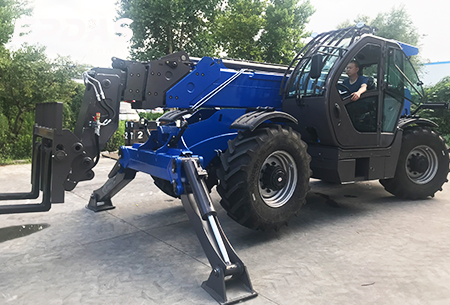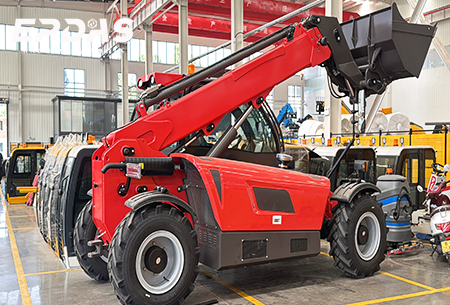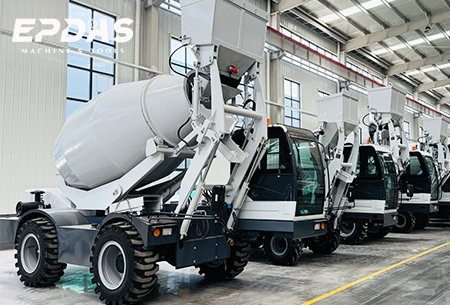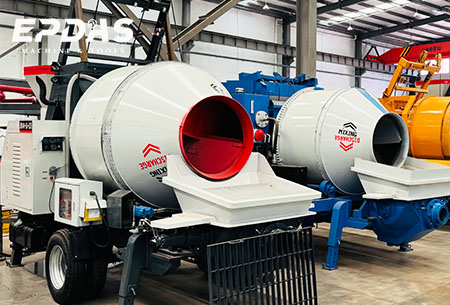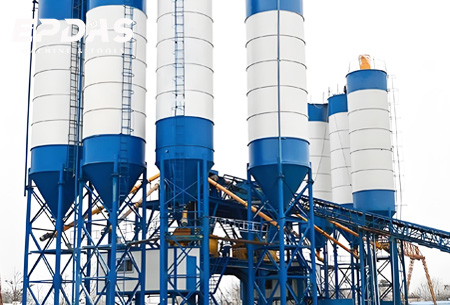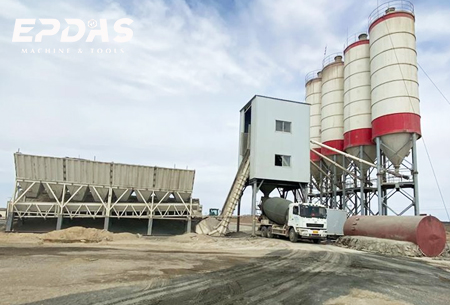As core equipment for construction sites, industrial and mining warehouses, and various types of construction sites, telescopic forklifts undertake the key tasks of high-altitude lifting, material transportation and stacking – whether it is light building materials such as bricks and wood, or heavy materials such as steel, all can be accomplished through their efficient work. As the core component of the equipment’s working device, the boom needs to withstand high-intensity and heavy-load working pressure for a long time. During continuous use, it is prone to faults such as weld cracking and fatigue failure due to stress accumulation, which becomes a potential hidden danger affecting the stable operation of the equipment.
During routine operation, “boom drop” represents a typical failure manifestation. This occurs when the telescopic boom suddenly sinks or descends slowly during material lifting or while maintaining a specific working height. Such failures not only interrupt workflows and reduce construction efficiency but also pose safety risks through falling materials or uncontrolled booms, threatening personnel and property. So, what are the specific causes of “boom drop” during telescopic forklift lifting operations? And how can this issue be effectively resolved? The following section will provide a detailed analysis.
Mechanical structural defects fall into two categories: Mechanical structural defects fall into two categories: first, component wear and aging; second, loosening at connection points.
Among the mechanical structural defects of telescopic forklifts, the wear and aging of key components are the primary causes of the “boom drop” phenomenon. The primary cause of boom drop in telescopic forklifts is the wear and aging of critical components.
High-load operations increase the clearance between the hydraulic cylinder piston and cylinder barrel, leading to internal oil leakage, pressure decay, and insufficient lifting force. Scratches and deformation on the piston rod accelerate seal component wear, while aged seals lose elasticity and degrade sealing performance, collectively causing the boom to sag.
Secondly, there is loosening at the connection points. The telescopic boom of a telescopic boom forklift is usually composed of multiple boom sections, which are connected to each other through pins, bolts and other connecting parts. During long-term operation, due to the vibration, shock of the telescopic boom forklift and the stress changes caused by the boom’s extension and retraction, the connecting parts at these connection points may gradually loosen.
During extension or retraction, the boom can no longer maintain structural stability. The relative positions between boom sections shift, causing deviations in force transmission. As shaking intensifies, the vestil forklift boom’s center of gravity shifts, ultimately leading to “boom drop” where construction materials scatter across the ground.
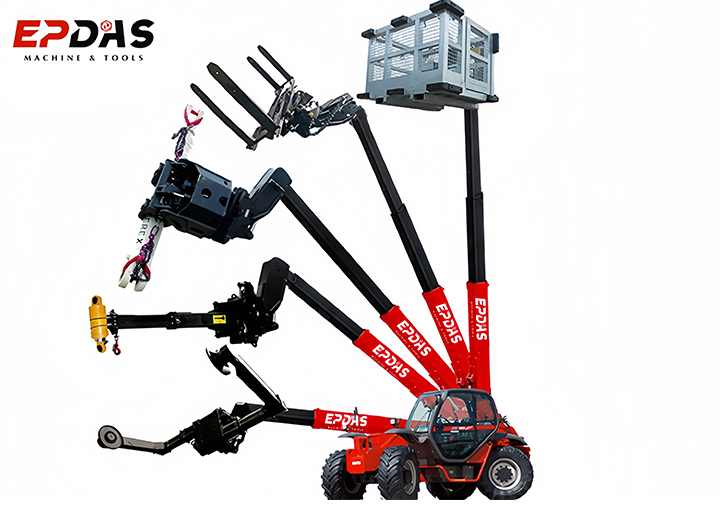
There can be three possible causes of hydraulic system failure: firstly, problems with the hydraulic oil; secondly, oil pump failure; and lastly, abnormal control valve issues.
Hydraulic oil, as the working medium for transmitting power and signals in hydraulic systems, plays a crucial role in the normal operation of the system in terms of its state. When metal shavings, dust or moisture and other contaminants are mixed into the oil, they will enter the oil pump, control valve and other precision components through the oil circuit, accelerating the wear of parts and causing pressure fluctuations, eventually leading to the “telescopic forklift boom drop” failure.
The deterioration of hydraulic oil is also a potential factor leading to “arm loss”. With the increase of usage time and the influence of the working environment, the additives in the hydraulic oil will gradually be consumed, and the chemical properties of the oil will change, causing a decline in its anti-oxidation, anti-wear and other performances, and eventually leading to the “loss of arms” situation.
The second issue is oil pump failure. As the power core of the system, the internal wear of the hydraulic oil pump will directly cause the “arm drop” failure. When precision components such as gears and plungers wear out due to long-term use, it will lead to internal leakage of hydraulic oil, attenuation of output pressure, and inability to continuously provide the stable power required to support the boom.
Meanwhile, the aging of the oil pump seals and the failure of the drive unit are also key causes. Seal failure can cause pressure leakage, while motor failure or loose drive belts can completely disable the oil pump.
The last issue is the abnormality of the control valve. The control valve controls the flow direction, pressure and flow rate of the hydraulic oil to precisely control the actuating elements. Valve core jamming (caused by impurities, wear, etc.) or wear can impede oil flow and lead to leakage. Spring failure, improper adjustment, and other factors can also have an impact, all of which may cause abnormal system pressure and result in “arm drop” faults.
Improper operation can result from two causes: first, overloading; second, non-compliant operation.
Each telescopic boom forklift has a clearly defined rated load capacity and lifting height limit to ensure the safety and stability of the telehandler forklift under normal working conditions. In actual work, some operators, in pursuit of work efficiency, take chances and ignore the load limit of telescopic boom forklifts, engaging in overloading operations.
When the load exceeds the rated capacity, every component of the telehandler—particularly the telescopic boom and hydraulic system—is subjected to immense stress. This excessive pressure causes the boom to deform excessively and concentrates stress beyond the material’s yield strength. Consequently, the boom’s structural integrity is compromised, ultimately leading to the “boom drop” phenomenon.

The second issue is illegal operation. In addition to overloading, improper operation is also one of the important reasons for the “arm drop” of telescopic boom forklifts when they are raised.
In the actual operation process, some operators lack professional training and safety awareness, and often perform illegal operations such as sudden stops and starts, and frequent lifting and lowering. Rough operation is an important human factor that leads to “losing one’s arm”. The severe impact caused by sudden stops and starts can directly damage the structure of the telescopic arm, leading to loosening of connecting parts and cracking of welds.
At the same time, the instantaneous pressure peak will accelerate the damage of hydraulic seals. Frequent lifting and lowering not only cause metal fatigue cracks but also lead to a rapid increase in the temperature of the hydraulic oil. When the oil temperature exceeds the critical value, it will directly result in a decline in system pressure.
The Boom Assembly of the telescopic boom forklift is one of the crucial core structures in the entire equipment. It determines the lifting height, working radius and load capacity of the equipment. The design of the boom integrates high-strength structural engineering and hydraulic control technology, enabling telescopic boom forklifts to maintain efficient, safe and precise working performance in various complex construction and handling environments.
The telescopic section is the core structure of the boom, composed of multiple sliding rectangular or polygonal steel sections. It is often composed of 2 to 5 box-shaped steel structural components with rectangular or pentagonal cross-sections stacked like telescopes.
With the aid of hydraulic drive, each section of the telescopic boom can freely extend and retract to adjust the boom length, meeting the operation requirements of different heights and distances. The segments are connected by rollers or wear-resistant sliders, which not only reduces the telescopic friction resistance but also ensures the smoothness of the movement, effectively enhancing the reliability and control accuracy of the boom operation.
The high-end model of extended boom forklifts can achieve a large extension ratio design, enabling high lifting while maintaining a compact body. The surface of the segments is coated with anti-corrosion paint or electroplated to enhance durability and wear resistance.

The modular design of the telescopic structure makes the equipment more flexible and efficient in transportation, storage and operation switching.
The hydraulic cylinder is the “power source” that drives the movement of the telescopic arm. By the thrust effect of high-pressure hydraulic oil on the piston rod, the hydraulic cylinder can precisely drive the boom of the telescopic boom forklift to complete the extension and retraction actions, providing stable and controllable power output for the boom movement. It is a key component to ensure the operational performance of the telescopic boom.
Telescopic Cylinder Assembly
As the power core of the boom, it is driven by hydraulic oil to achieve the extension and retraction of the boom section. The sequential telescopic technology is adopted to achieve the synchronous movement of multiple arm sections, or an independent cylinder solution is provided to offer stronger thrust. The precise sealing system ensures stability and no leakage under high-pressure conditions.
Electro-hydraulic Control System
The EPDSA motion control of the telescopic boom depends on the coordination between the electronic joystick and electro-hydraulic proportional valves. Pressure fluctuations can cause issues such as“boom drop”or“vibration.”Through proportional control valves and an intelligent control system, operators can achieve precise control.
The advanced hydraulic control system not only enhances the operational experience but is also the key to ensuring safe and efficient construction.
The boom head of a telescopic boom forklift is located at the very front end of the boom and serves as an important interface for connecting various attachments. According to different work requirements, operators can quickly replace various attachments, such as pallet forks, buckets, hooks or booms, etc.

The entire boom is made of high-strength alloy steel or special structural steel to ensure stability even when subjected to heavy loads, torque and impact forces. The design of high-strength materials can significantly extend the service life of the boom and ensure its safety performance during long-term operation.
The welded structure undergoes ultrasonic testing and fatigue testing to ensure the reliability of each weld seam.
Local reinforcement plates and closed box structures are adopted to enhance the bending and torsional stiffness.
The outer layer is coated with an anti-rust coating or powder coating to enhance corrosion resistance and service life.
The boom system of modern telescopic boom forklifts is usually equipped with multiple electronic and hydraulic safety devices. Enable operators to have an intuitive understanding of the boom status under any working conditions, significantly enhancing the safe operation experience.
The limit sensors of the safety monitoring system work in coordination with the Angle load sensing system to monitor the extension length, working Angle and load status of the boom in real time, effectively preventing over-range operation and overload risks, and ensuring the stable operation of the equipment within a safe range.
The automatic arm lock valve starts immediately when there is a hydraulic abnormality to prevent the boom from accidentally sliding down. The intelligent control screen visually displays the current arm length, Angle and safe load range, providing precise data support and safety warnings for the operators.
Checking the hydraulic oil of the telescopic boom forklift, it should be ensure that the oil level is within the range indicated by the dipstick and the oil quality is clean and transparent. Timely deal with emulsification or contamination to ensure the stable operation of the system and extend its service life.
Observe whether there is any oil leakage from the piston rod of the oil cylinder and the pipe joints. If necessary, use a pressure-holding test to confirm the internal leakage. Once it is found that the sealing ring is aged, worn or deformed, the original factory specification sealing parts should be replaced immediately.
Use a pressure gauge to test for internal leakage in control or check valves, or contact a qualified technician for service.
Focus on inspecting the sealing performance of the oil cylinder and the pressure-holding capacity of the system. Replace aged sealing parts and filter elements in a timely manner to ensure that the cleanliness of the hydraulic oil meets the standards. At the same time, clean the fuel tank and expel the air to restore the sealing performance of the system.
Use professional equipment to inspect the key welds and slider clearances of the boom, correct the straightness of the boom, and eliminate potential risks caused by structural deformation or wear.
Recalibrate the Angle and pressure sensors, and adjust the response parameters of the safety valve group to ensure the accuracy and reliability of the control system.
After implementing targeted maintenance, full-load tests should be conducted and the operation data should be continuously monitored. Establishing a regular inspection system every 500 hours can effectively prevent the recurrence of faults and improve the comprehensive utilization rate of equipment.
In conclusion, as a core handling equipment in fields such as construction and warehousing, the stable operation of the boom system of telescopic boom forklifts is directly related to work efficiency and on-site safety. High-quality boom components are the prerequisite for performance assurance, while systematic equipment management and regular maintenance are the keys to preventing faults.
By continuously optimizing the maintenance, structural inspection and safety monitoring mechanisms of the hydraulic system, and strengthening operator training, safety risks such as “arm loss” can be effectively reduced. With the continuous application of intelligent monitoring and automatic early warning technologies, future tele boom forklifts will achieve a higher level of safety and efficiency, enabling the equipment to maintain stable operation in complex working conditions and providing more solid operational guarantees for various engineering projects.
